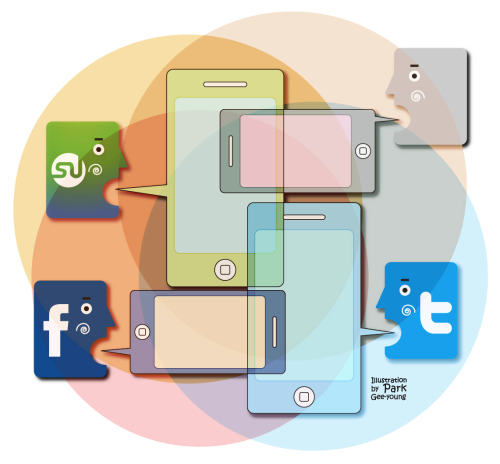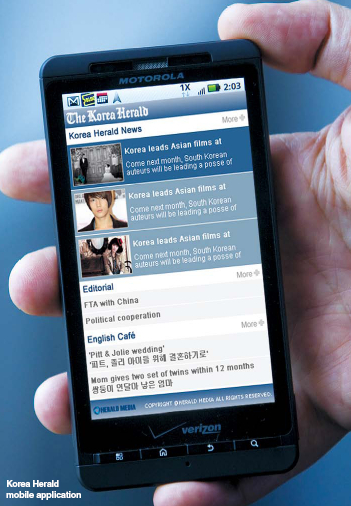In new multi-platform media environment, news is becoming portable, personalized, and participatory
When a massive landslide hit an affluent residential town in southern Seoul on July 27, it was ordinary citizens, not professional journalists, who broke the news.
An amateur video capturing a torrent of mud rushing toward apartments spread through video-sharing and social media sites before the tragic scene appeared on any traditional news outlets.

Innumerable messages, pictures and videos by citizens rippled through the Internet and mobile media throughout the day, offering a vivid, up-close look into flooded streets, broken roads and people escaping the disaster.
People turned to Twitter and Facebook for immediate accounts of the havoc wreaked by heavy rains.
It was yet more evidence of how social media is changing the way news is uncovered, gathered and distributed.
The rise of viral communications platforms is stripping mainstream outlets of their dominant position and turning them into a part of a broadly dispersed ecosystem of sharing information.
“It’s an ongoing, real time, two-way collaboration in which the distinction between producer and consumer will grow increasingly hazy. Reading the news is no longer passive, it’s active,” Arianna Huffington, co-founder of the Huffington Post, wrote to Business Insider, a U.S. business news website.
Social media and mobile tools allow people to better share news anytime, anywhere. Connected readers are sometimes faster than journalists who used to have substantial access to information, and they actively participate in developing and distributing stories.
Journalists often check blogs, Facebook, Twitter and other social networking services to get new ideas and find out what readers want to know.
“Reporters can’t produce good stories if they don’t listen to their readers. It is like Samsung putting efforts to understand consumers’ expectation on new mobile handsets,” Kim Gwang-hyun (@Kwang82), a Korean journalist specializing in the IT industry, said.
Twitter is a “must” for reporters to get ideas on news stories, he said. Kim has more than 62,000 Twitter followers and said he has a list of about 300 IT experts constantly checking uploads.
“The future of news is more about ‘stories’ than ever before. Citizen journalists have a bigger voice in covering news events via social media, leaving more room for traditional journalists to seek out in-depth stories,” Erin Burnett, CNN Anchor, was quoted as saying by Business Insider.
Professional journalists rely on citizen reporters, filtering, fact-checking and analyzing their articles and images. They face a dilemma in assessing how to integrate user-generated footage into their coverage as a considerable amount of noise and false information are also generated by SNS.
When a massive landslide hit an affluent residential town in southern Seoul on July 27, it was ordinary citizens, not professional journalists, who broke the news.
An amateur video capturing a torrent of mud rushing toward apartments spread through video-sharing and social media sites before the tragic scene appeared on any traditional news outlets.

Innumerable messages, pictures and videos by citizens rippled through the Internet and mobile media throughout the day, offering a vivid, up-close look into flooded streets, broken roads and people escaping the disaster.
People turned to Twitter and Facebook for immediate accounts of the havoc wreaked by heavy rains.
It was yet more evidence of how social media is changing the way news is uncovered, gathered and distributed.
The rise of viral communications platforms is stripping mainstream outlets of their dominant position and turning them into a part of a broadly dispersed ecosystem of sharing information.
“It’s an ongoing, real time, two-way collaboration in which the distinction between producer and consumer will grow increasingly hazy. Reading the news is no longer passive, it’s active,” Arianna Huffington, co-founder of the Huffington Post, wrote to Business Insider, a U.S. business news website.
Social media and mobile tools allow people to better share news anytime, anywhere. Connected readers are sometimes faster than journalists who used to have substantial access to information, and they actively participate in developing and distributing stories.
Journalists often check blogs, Facebook, Twitter and other social networking services to get new ideas and find out what readers want to know.
“Reporters can’t produce good stories if they don’t listen to their readers. It is like Samsung putting efforts to understand consumers’ expectation on new mobile handsets,” Kim Gwang-hyun (@Kwang82), a Korean journalist specializing in the IT industry, said.
Twitter is a “must” for reporters to get ideas on news stories, he said. Kim has more than 62,000 Twitter followers and said he has a list of about 300 IT experts constantly checking uploads.
“The future of news is more about ‘stories’ than ever before. Citizen journalists have a bigger voice in covering news events via social media, leaving more room for traditional journalists to seek out in-depth stories,” Erin Burnett, CNN Anchor, was quoted as saying by Business Insider.
Professional journalists rely on citizen reporters, filtering, fact-checking and analyzing their articles and images. They face a dilemma in assessing how to integrate user-generated footage into their coverage as a considerable amount of noise and false information are also generated by SNS.

Rise of social media
A recent survey showed that social media are growing fast as influential tools for directing people to news.
The Pew Research Center’s Project for Excellence in Journalism in May released a study on the flow of traffic to the Web’s 25 largest news destinations during the first nine months of last year.
Facebook was responsible for 3 percent of traffic to the 21 news sites that allowed data to be tracked. Five of the sites studied got 6 percent to 8 percent of their readers from Facebook.
Google remained dominant, supplying about 30 percent of traffic to the top news sites.
While Google uses an automated formula, Facebook-originated traffic comes from links posted by friends or “like” buttons, meaning people rely on their online social circles for content that interests them.
“If searching for the news was the most important development of the last decade, sharing the news may be among the most important of the next,” the Pew report said.
It took only two years for Facebook to secure 5 million users around the world while radio took 38 years; TV 13 years and the Internet four years.
It has 729 million users around the world while Twitter has 200 million. Twitter users send 1 billion tweets a week, according to reports.
The popularity of Facebook and Twitter is also rapidly growing in Korea. According to Facebakers.com, Facebook membership in Korea rose to 3.8 million in July from 1.78 million in Nov. 2010. The country ranked 34th last month in terms of number of users.
Their influence is growing with the development of diverse online and mobile platforms. Another research by the Pew Research Center showed that the overwhelming majority of Americans, 92 percent, use multiple platforms to get their daily news.
“In today’s new multi-platform media environment, news is becoming portable, personalized, and participatory,” it said.
The survey showed 33 percent of cellphone owners now access news on their cell phones; 28 percent of Internet users have customized their home page to include news from sources and on topics that particularly interest them; and 37 percent of internet users have contributed to the creation of news, commented about it, or disseminated it via postings on social media sites like Facebook or Twitter.
Revenues for newspaper companies declined in 20 out of 31 Organization for Economic Cooperation and Development member nations between 2007 and 2009, including Korea (6 percent), the U.K. (21 percent) and the U.S. (30 percent).
They have lost significant revenue to portal sites and search engines that act as a news aggregators.
In the face of declining readership and advertisement revenues, newspaper publishers are exploring new business models based on mobile services and social media.
Optimistic analysts say by utilizing mobile applications and social media, media companies could build stronger ties with readers and provide tailored news that would pave the way for paid content service, advertisement and new business opportunities.
“Users could be more likely to spend money on mobile contents and they will seek personalized contents, especially services that allow public to communicate with many people anytime and anywhere,” Lee Jae-shin, a professor of mass communication at Chung-Ang University said.
But though media groups are rushing to develop a few applications for smartphones and tablet PCs, how to charge for content on the web and mobile devices is a big question mark.
Currently, most media groups in Korea are distributing mobile apps for free, according to data collected by the Korea Press Foundation. But they are trying to charge for content to makeup a deficit caused by declining readership and loss of classified ads to online media.
“Media groups in Korea are in the state of exploring ways to develop new business models to help increase revenues,” said Doh Joon-ho, communications professor at Sookmyung Women’s University.
“But they should learn a lesson from their failure to use user created content to build a new income model.”
By Cho Chung-un and Park Han-na
(christory@heraldcorp.com), (hnpark@heraldcorp.com)










![[Hello India] Hyundai Motor vows to boost 'clean mobility' in India](http://res.heraldm.com/phpwas/restmb_idxmake.php?idx=644&simg=/content/image/2024/04/25/20240425050672_0.jpg&u=)








